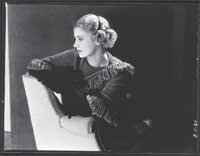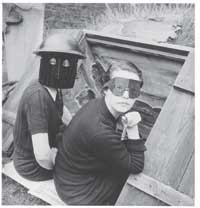From model to muse to war photographer Lee Miller’s extraordinary life is revisited with a major retrospective at Paris’ Jeu de Paume (to January 4, 2009). This retrospective presents the many facets of the career of this remarkable 20th-century artist who was by turns a fashion and artists model, then muse of the Surrealists (companion and assistant of Man Ray) and finally photographer. The exhibition Includes vintage prints, original copies of Vogue, drawings and collages, plus a short excerpt from the Jean Cocteau film “Le Sang du Poèt” (1931) in which Lee Miller plays an important part.
The exhibition is organized by chapters in Miller’s life. Opening with her early experiences as a model (1927-1932) we learn that Miller acted as a model for her father for whom she frequently posed nude. She came to be considered one of the most beautiful women of her age beginning her career in New York in 1927. Thanks to Condé Nast, the founder and director of the magazine, she became the star model of Vogue, and was soon the muse of numerous photographers such as Steichen, Man Ray, Horst and Hoyningen-Huene.
Miller’s Paris years (1929-1932) started with a letter of introduction written by the photographer Steichen to Man Ray. She became Ray’s assistant, model and companion. During these years she continued to pose as a model while learning photographic technique. For French Vogue she worked both sides of the lens. She began doing portraits, fashion photographs and, in the Surrealist spirit, solarizations, a process popularized by Man Ray.
When Miller left Man Ray in 1932 she went back to New York where she opened with her brother a studio on 48th Street. She told a journalist at the time that she would rather “take a photograph than be one.” Clients of the Miller Studio included Vogue, Elizabeth Arden, Helena Rubinstein and Saks Fifth Avenue. The gallerist Julien Levy gave Miller her first solo photography exhibition in 1933.
In June 1934 Miller married Egyptian Aziz Eloui Bey and moved to Cairo. Some of Miller’s finest photographic work was done during her Egypt years (1932-1939) when she took pictures of the streets of Cairo, the desert, ruins, monasteries and abandoned Egyptian villages. With the Second World War (1939-1945) Miller left her Egyptian husband and moved to London to be with painter Roland Penrose. Here she worked for British Vogue producing a steady output of fashion photographs, portraits and documentary photographs. In December 1942 she became an accredited war correspondent for the US Army for Vogue but continued to take photos in Great Britain. In September 1944 she did a report on the work of the nurses who followed up the Normandy landings, then went to photograph the Liberation of Paris, and the battle of Saint-Malo. In 1945 she followed the campaign in Alsace and the fall of the Third Reich. Her photographs of the liberation of the concentration camps Buchenwald and Dachau were published in the American edition of Vogue in June 1945.
After photographing Vienna, Hungary and Romania, Lee Miller returned to London to be with Roland Penrose, whom she married in May 1947. The exhibition ends on a somewhat “triste” note telling that in 1953 she called it a day on her photographic career with her last pictures for British Vogue entitled “Working Guests.” With these photographs and throughout her career Miller never lost her Surrealist eye. One leaves the exhibition with the impression that for Miller art was just as much about living as photographing.
L‘ART DE LEE MILLER. To January 4, 2009. At Jeu de Paume.



